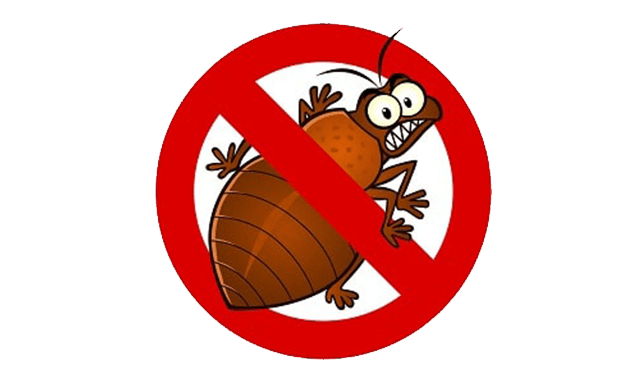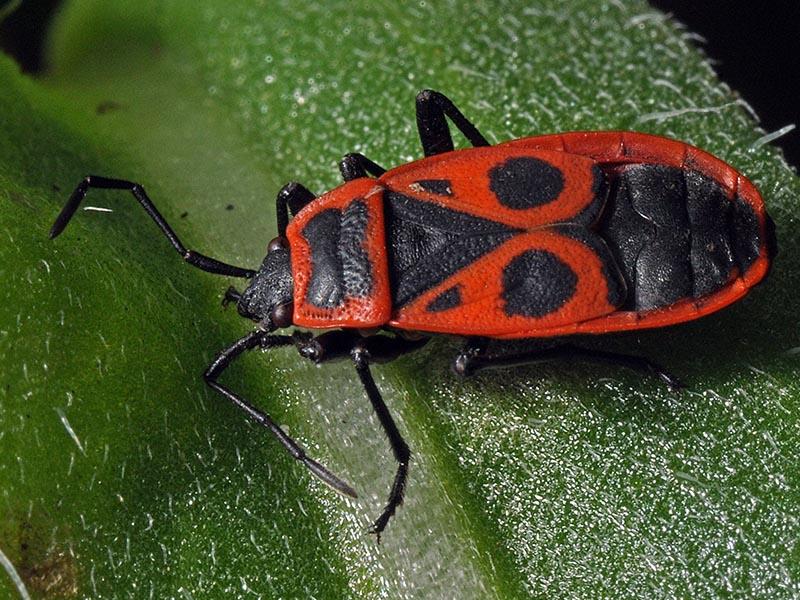
I had already cleared the perimeter of old trees, uprooted two stumps, mowed the grass, and paved part of the yard with tile. That alone was not enough, but to completely fill the yard with concrete is not the answer. I want to keep the vegetation in front of the house. It is known to be one of the food sources for these pests. Help me understand whether bed bugs are really worth worrying about: are they bad for people, plants. If you can, reveal a few secrets on how to reduce the number of soldier bugs. Thanks in advance. Victor.
The author of the portal answers the question:
In my material below, you will learn how to avoid an infestation of soldier bugs on your property.
What a bedbug soldier looks like. Close-up photos
Body length medium - 9 to 11 mm. The insects are brightly colored in black and red tones. Specimens are visible in the grass, but few people destroy them on purpose, since there are such pests ubiquitous. Their other outward signs are:
- Six limbs in black;
- 1 pair of tendrils;
- flattened oval calf;
- the pattern on the back is specific: an inverted sharp triangle, 2 circles, and the main color of the outer covers is red, and the elements of decoration are black;
- Insects have eyes, and if you look closely, you can see that they are also red;
- rear wings are most often absent, which depends on the species;
- The mouth apparatus is of the stabbing-sucking type; the insect uses an elongated proboscis to get a portion of food.
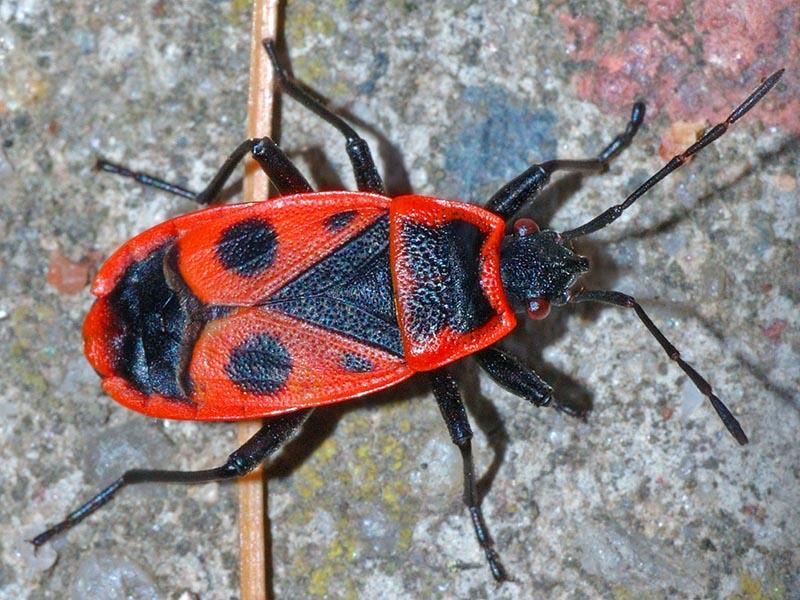
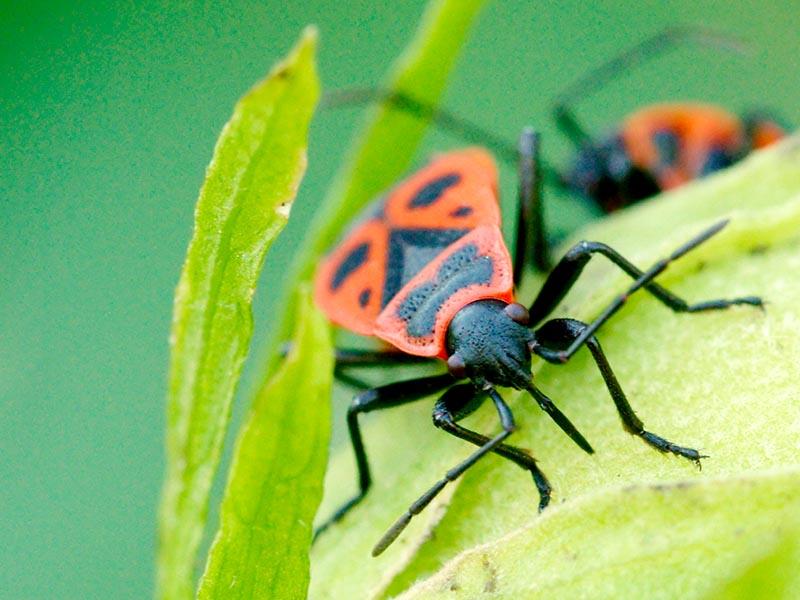
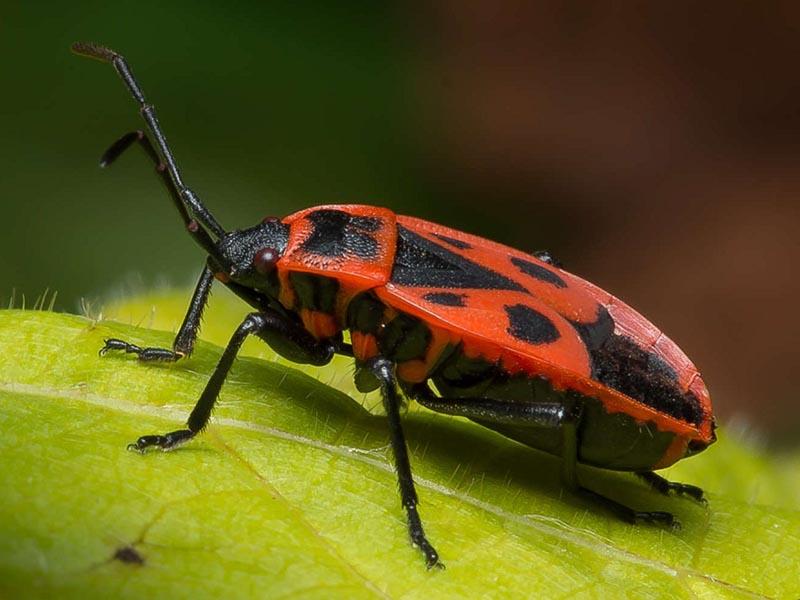
Features of the red-winged wingless. Description
Many people have seen this pestbut often did not pay attention to it.
However, when the breeding rate increases, it becomes necessary to control the number of such individuals.
To influence this process, we need to know where they hide, how they develop, what they fear, and how they eat Insects.

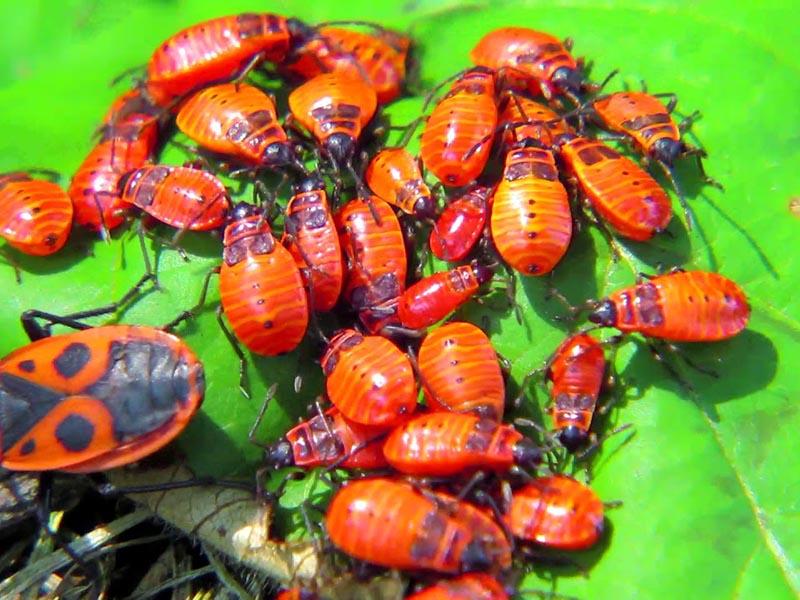
Where does he live
Red bedbug looks bright, but it is no longer noticed because the pest is found ubiquitous. It lives in different conditions, can tolerate hot and cool climates, but this affects the peculiarities of development.
It is found in Europe, the United States and Central America, Mexico, Asia, North Africa.
Bedbugs soldiers can live in different places, but most often they accumulate on trees (at the bottom), stumps, fences. Specimens live also simply on the ground, can crawl in large numbers on the walls of barns, garages. And they choose to live on the southern side, where there is more sun during the day, and hence enough heat.
You can meet insects in your vegetable garden, in the garden, in the homestead, directly next to the house, and sometimes - inside, but these are rare cases. Pests crawling around the city, they are often found right underfoot, even on the pavement. They are regulars in city parks, and can even live in areas along the road.
This means that the number of such bedbugs high enough, they are everywhere, but do not cause indirect harm to humans as long as they find food for themselves.
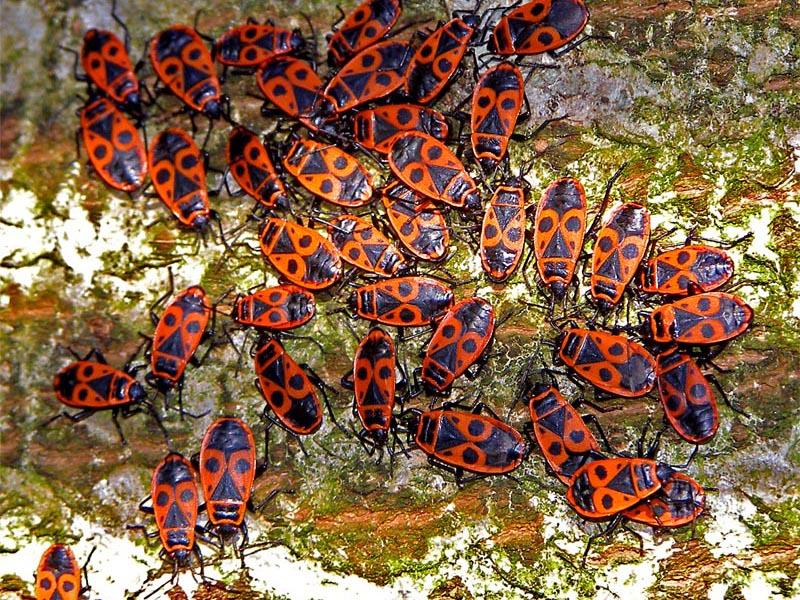
What it feeds on
Red bedbugs soldiers destroy all kinds of food:
- pollen;
- plantation sap;
- seeds;
- insects, invertebrates;
- fruit.
And such Insects are equally dangerous to herbaceous plants, trees, shrubs, and human crops.
They contribute to the deterioration of crop quality, negatively affect the development of plantations.
And the type of plant does not play a role for them. They also attack various creatures (snails, worms, other insects, as well as their fellow redbugs).
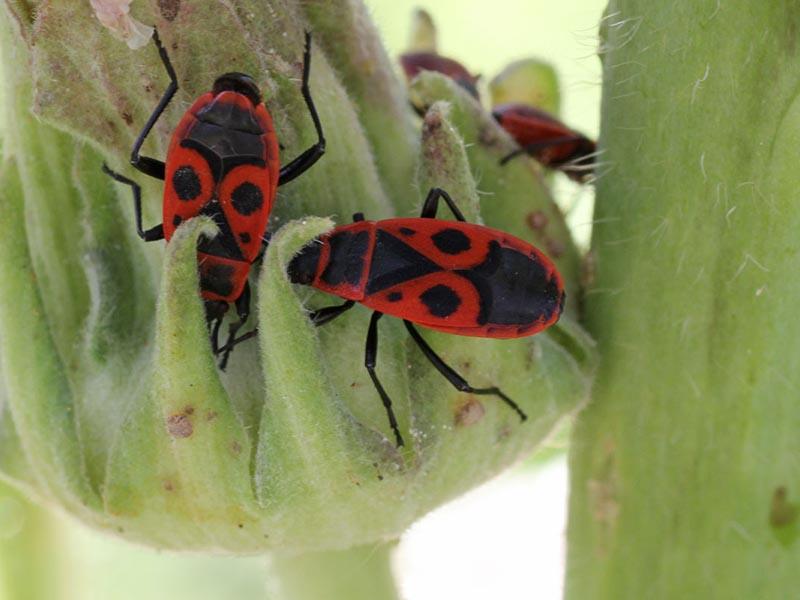
Life cycle and reproduction
The pests can be seen in the spring, when the air temperature, it will be steadily warm. They begin to destroy the weeds, plants that they find nearby. They have no wings, so they cannot travel significant distances. When the red-black bugs get full, they multiply. As a result, the first clutches appear as early as late spring or sometimes as late as April (depending on environmental conditions) eggs - up to 30 pcs.
Bed bugs leave them on plants, in the crevices of tree bark, but you can often find another picture - the eggs mature right on the ground (surface layer).
The color of the masses changes. At first, the eggs are yellowish in color. Then they darken. This is due to the fact that the shells are transparent, through which you can see how the bedbug develops. The duration of egg maturation also varies, depending on environmental conditions, and is 6-16 days. At the next stage, larvae appear. Redbugs are not among the insects that have a complete transformation cycle. They skip the stage of pupal formation.
The way soldiers reproduce is original. The insects hitch to each other with the hind parts of their bodies. This is how mating takes place, and it is a long process. Bed bugs can stay in this position from several hours to 1 week. And the female cannot mate with another male during this time. During mating, the insects are able to move around, they do not remain stationary for the entire period.
Wingless Cossack winters with his brethren.
Insects gather together, numbering up to 1 hundred individuals. Favorite habitats:
- beneath the bark;
- in the crevices of the stumps;
- a leafy substrate;
- basements of houses.
Insects wake up during temperature changes. They need food. Considering that plants also "sleep" in winter, it is almost impossible to find greenery, bed bugs begin to destroy their fellows. When insects eat individuals of their own species, this is called cannibalism.
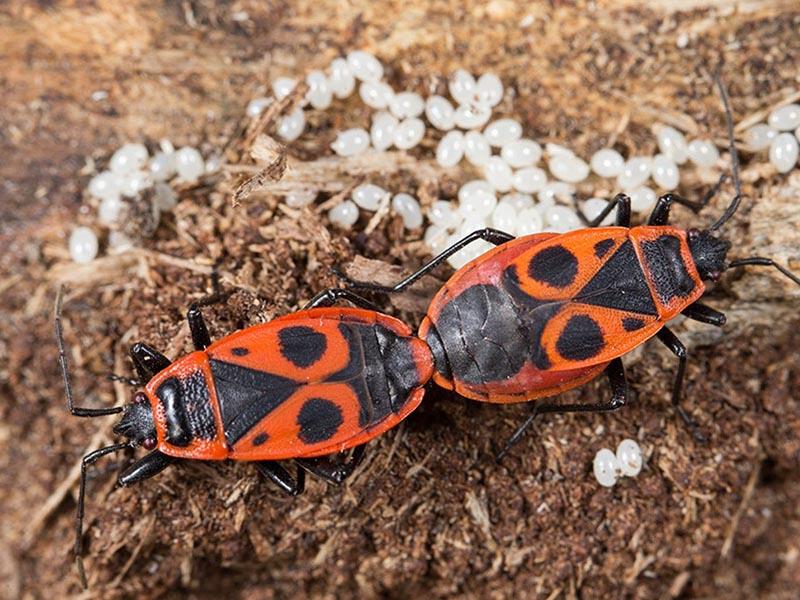
Larvae
Such individuals are much like their adult relatives, imago. However, they do not become red-black right away.
When emerging from the egg, the larvae are characterized by the red color of their outer covers.
They look almost the same as adults, the difference is in some body parameters:
- larvae are small - their size barely exceeds 1 mm;
- The bug is red on top, but the pattern gradually begins to show.
Otherwise, such individuals look like sexually mature ones:
- 3 pairs of limbs;
- 1 pair of tendrils;
- The body is oval, flattened from above;
- there are eyes.
The limbs are also red. It is this peculiarity of the larvae that allows us to observe the change in the color of the eggs, because a red hue appears only near the end of the developmental period. By this time, the young acquire a red color, which becomes visible through the shell of the eggs.
The larvae feed in the same way as adult insects - with a stabbing-sucking mouthpiece. But such pests prefer to drink sap from young plants and trees. They do not have a stronger proboscis yet, so they are not able to use it freely. For the larvae on the site are available those plants that have just begun to develop.
But they enjoy sucking the sap from the birch tree, a favorite treat of the adults as well.
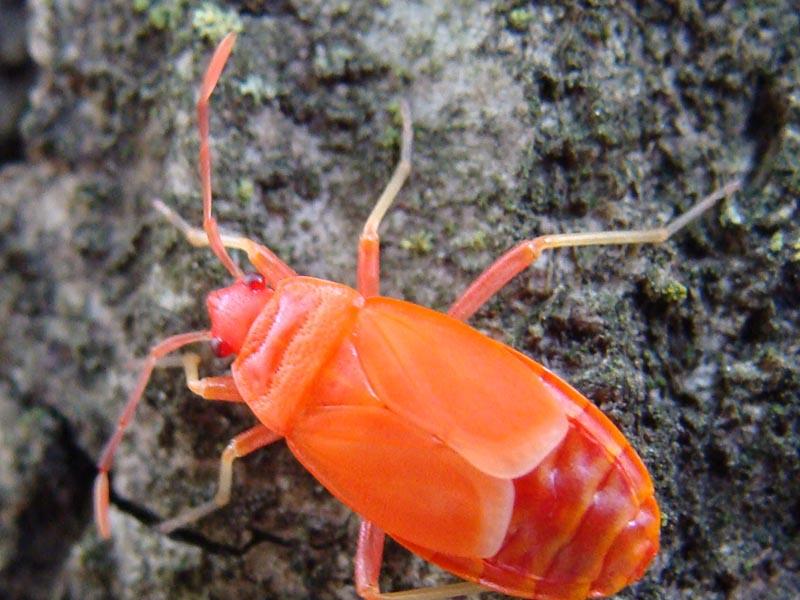
Bed bug bites soldier on
Weed insects on the site because of the risk of attack is not advisable. Such pests do not pay attention to people. They are busy minding their own business.
Humans are not interested in bed bugs at any stage of development (not just until they turn into adults).
Their mouths are not designed for piercing people's skin is tough enough. Which means you shouldn't be afraid and in a hurry kill soldiers until they settle into their new territories.
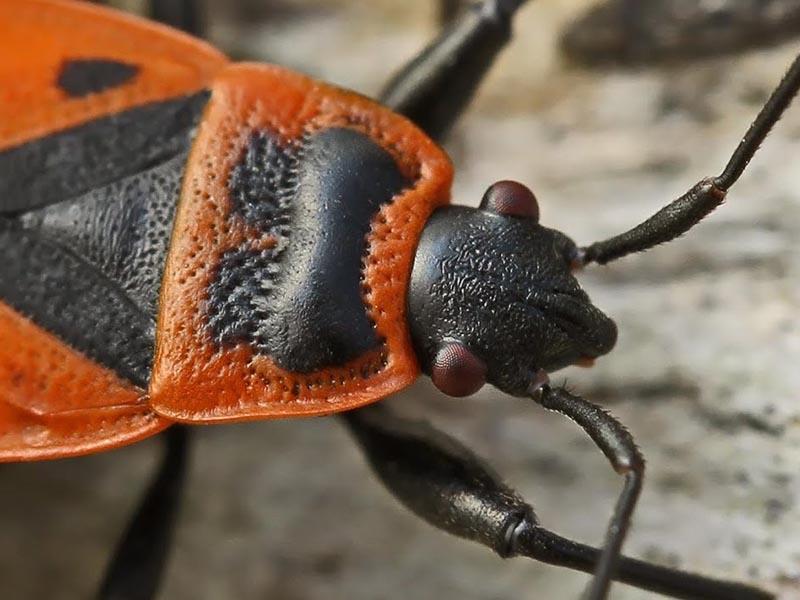
Interesting facts about red bugs
Beetles (not really, but many people call them that) with black dots are distinguished by their original coloration and unusual habits (e.g., when mating). Other interesting factors:
- bedbugs are not singles, they gather in groups, sometimes numbering in the hundreds;
- If you scare the insect, there will be a faint unpleasant smell, it is a defensive reaction and a way of communication between brethren;
- because of the color scheme. pest are often mistaken for individuals of other species;
- Lives shorter than many bed bugs (e.g., bed bugs or tree bugs) - 6 to 12 months.
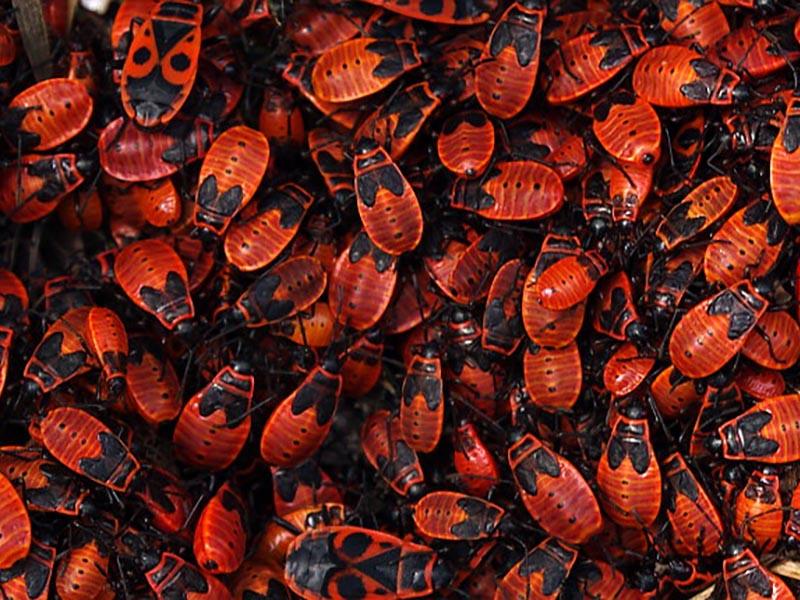
Synopsis
The most common one that exists: if a beetle with black dots (soldier) appeared at home, it could mean that a cataclysm is approaching soon, for example, there may be a fire or flooding.
There is a possibility of worsening weather conditions - insects are predicting a hurricane.
Then they tend to find a more reliable shelter - they climb into human homes.
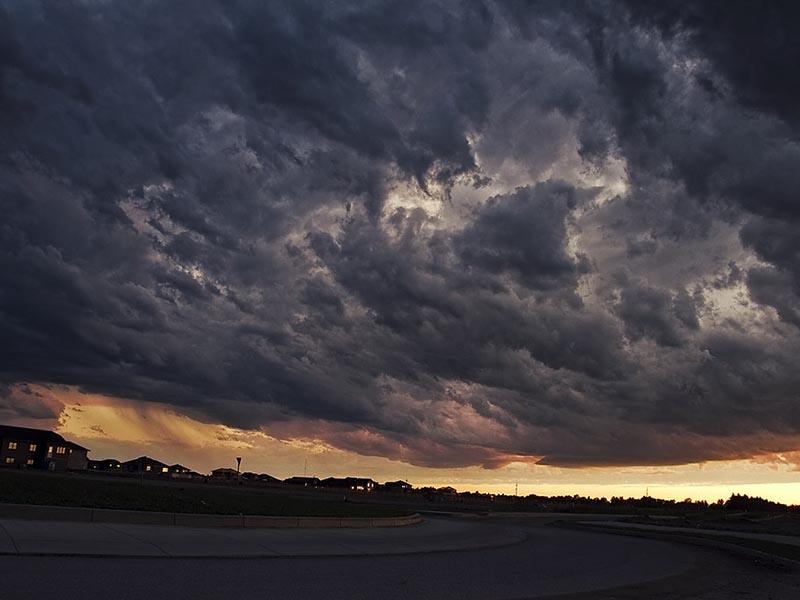
What is often confused with
The most common of these pests are mistaken for ground bugs. They represent the family of land bugs (according to taxonomy, the infraorder Pentatomomorpha). Bed bugs of this group are literally indistinguishable from soldier bugs in appearance. The similarity is due to their parameters:
- black and red coloring, but the spots are arranged differently, they also differ in shape - in the center the element of decoration in the form of a cross, at the end you can see white dots on a black background, most of the body is red;
- a flat body with an oval shape;
- eyes are black;
- 3 pairs of limbs;
- 1 pair of tendrils;
- body length - different, depends on what species are considered, on average is 1-12 mm.
Most often such pests feed on seeds, but the diet is determined by the membership of one or another group of bed bugs, some representatives are oligophagous, others are polyphagous.
There are about 990 species of insects of the family of terrestrials.
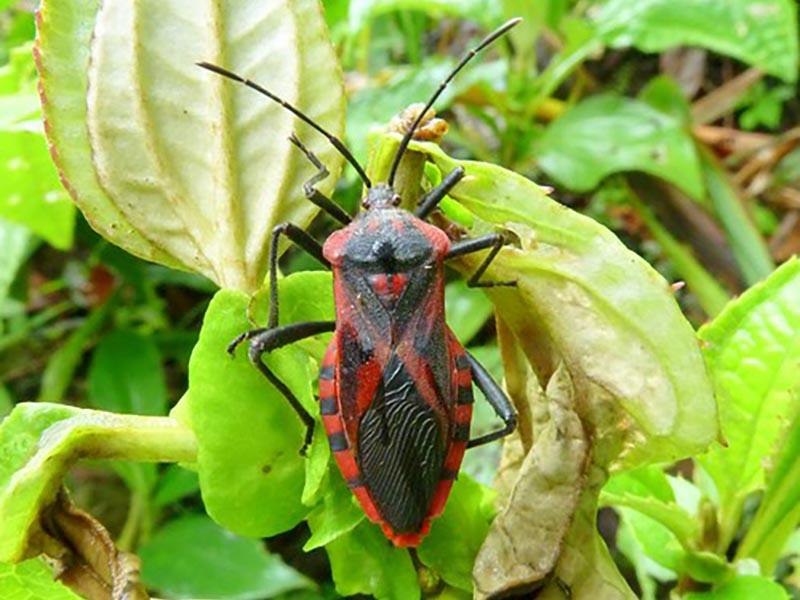
Fire Beetle
This pest is often confused with the soldier. However, in this case, the reason is not in the external resemblance, but in the name.
So, the soldiers are not beetles, but bedbugs, yet they are so called because of their bright red and black coloring.
Few people think about the fact that they are misleading themselves and others. The fact is that there is actually a "firebug" in nature. Only it is not a bedbug, but a beetle, and the soldier does not belong to this species according to systematics. The official name is softbug. The peculiar appearance is due to its kinship with crickets, fireflies.
Features of a true firefighter:
- coloration is black and red, but the body is mostly black, only some areas (pronotum, some limb segments, the sides of the body);
- The shape of the body of the pest is also different - elongated, narrow;
- body length - 1.5-2 cm;
- despite appearances, the insects' shells are soft.
You don't need to spend a lot of time researching information on what a soldier bug looks like, because the difference between the pests is obvious even at first glance.
Another peculiarity is that the softbug is a predator, which cannot be said about the redbug.
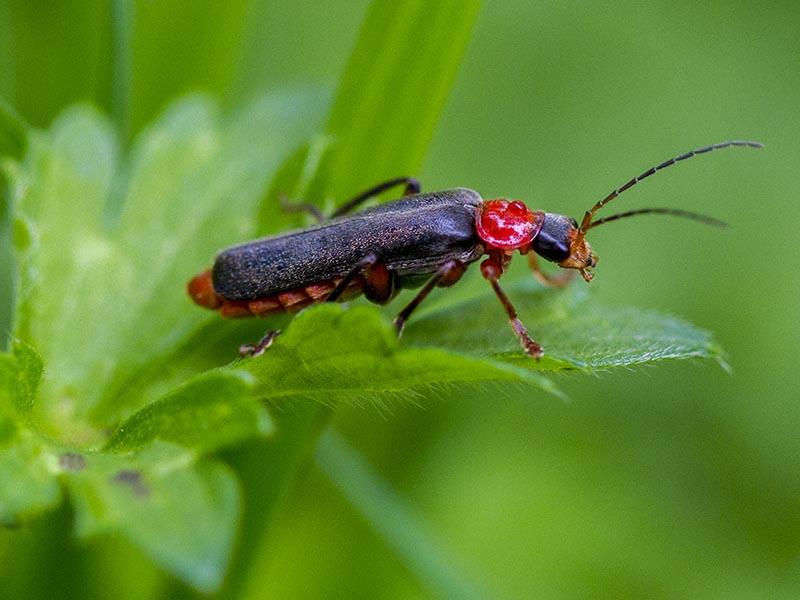
What harm and benefits a bedbug can bring
Until now, such pests have a reputation as non-hazardous insects. However, this has not been true for a long time.
Pests can destroy crops, especially if young and hungry larvae are around.
Other problems that come along with a parasite infestation of the site:
- seedling elimination;
- death of formed flowers;
- One of their favorite varieties of food is grapes, with little left of the berries;
- deformation of the green part of the plants;
- deterioration of appearance, which is especially important for ornamental flowers;
- The bed bugs feed on seeds, and as a result, they do not sprout;
- Bed bugs also cause harm indirectly - sometimes they destroy even species of insects that are beneficial to humans.
There is no particular benefit from such insects.
Only indirect help is noted. For example, the soldier can destroy other pests dangerous for the garden and vegetable garden. In addition, invertebrates, which can also undermine useful plants, make up its diet. This means that when evaluating the harms and benefits of having such bed bugs near beds, each of the positive and negative aspects is taken into account.
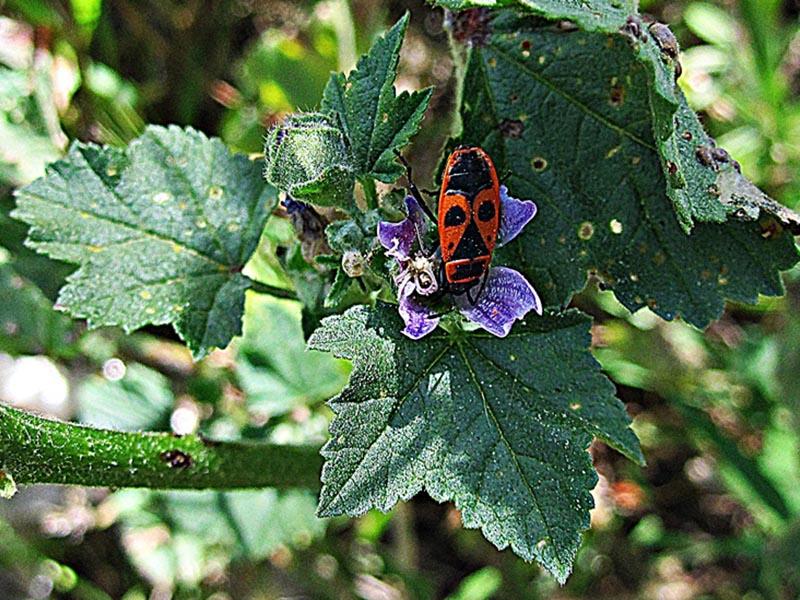
Signs of the appearance of wingless soldier bugs in the garden
A number of characteristic manifestations are noted:
- Leaf damage, first spots of a different color appear, then the entire leaf dies off, and soon it falls off;
- The tops of beets and other root crops wither;
- not only the leaves fall off, but also the flowers and fruits;
- inhibition of plantation growth.
Most often the perpetrators themselves are found.
In insects of this type, development follows a standard pattern. As a result, the need for food arises in the larvae as well. Young specimens are often caught by eye - they are completely red. The imago is distinguished by its bright coloration.
Video: soldier bugs, how not to be confused with other bugs, what they eat, how they harm the garden
How to get rid of bed bugs in the house and apartment
Start struggle The pest should be dealt with as soon as it is detected. At home and in the garden methods miscellaneous.
In the first case, it is sufficient to remove the insects mechanically.
A more serious fight is waged against parasites:
- apply agro-technical methods (burning alfalfa, legumes, planting bedbug repellent plants, digging beds);
- involve the destruction process and the natural enemies such insects, they include some birds, spiders, parasitic bugs (Laelaptidae, Phytoseiidaede), mantises, bats, but you can not always control their numbers, so if you have no experience it is better not to use this method of pest control soldiers;
- Biopreparations: consider treating infected plants with agents based on fungal spores, they are the best to cope with larvae.
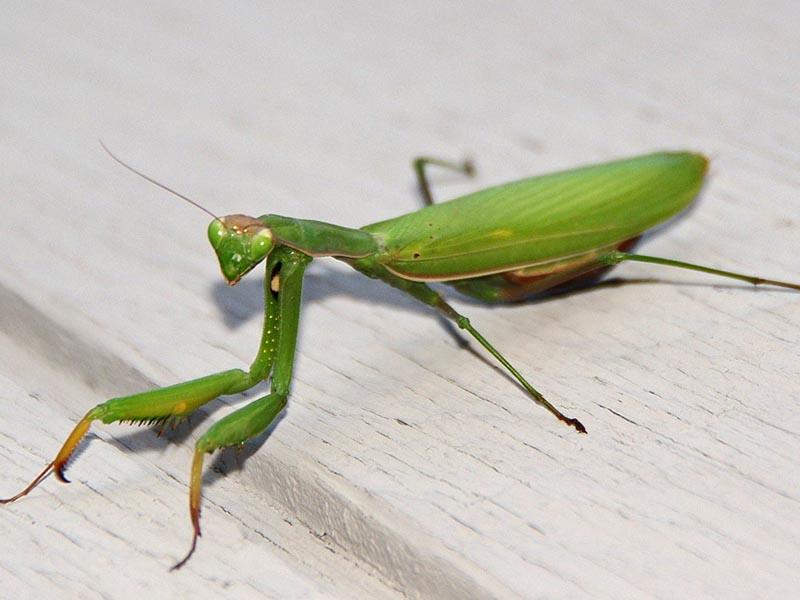
Folk methods of action on bed bugs soldier
Effective methodswhich are used when the site is mildly to moderately infested:
- soap solution: 10 l of water, 300 g of detergent;
- mustard powder (100 g) and water (5 liters), pour hot liquid;
- waste when peeling onions: fill a bucket with onion husks up to half, then - add water (it should reach the top), after 5 days you can apply, straining the remedy.
If one chooses the method, how to fight with bed bugs soldier on, you need to keep in mind that folk methods do not kill the insects, but slowly drive them out and create intolerable conditions.
Emphasis is placed on protecting the site from pestswhich may appear. If you need to find a way to get rid of soldier moths, this is one of the best options, because they are not harmful until they start migrating in search of better conditions, food. A site that is regularly cultivated will not do them any good.

Chemicals (insecticides)
When the soldier becomes dangerous (attacks cultivated plants), you can quickly get rid of it by using toxic drugs:
- Carbofos;
- Actara;
- Bancol et al.
Processing should be carried out at different periods:
- before the start of flowering, since many preparations are dangerous for bees;
- 2 weeks after the first treatment, when larvae emerge from the eggs;
- in mid-summer or already in the fall - after the last harvest (a preventive measure).
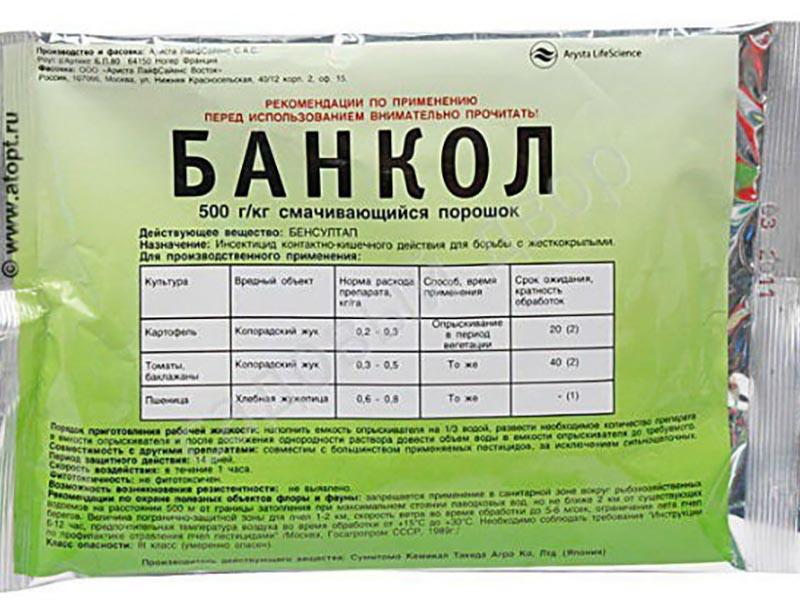
Bug prevention
To prevent site contaminationIf there are soldier bugs nearby, how to get rid of them - you need to take a number of measures:
- Remove all wild vegetation (weeds), collect organic debris, and remove it as far away from the site as possible;
- plant herbs with a strong odor (wormwood, clopogon) along the perimeter;
- dig over the surface layer of the soil, there may be eggs left behind;
- вThey are uprooting old stumps;
- treat the underside of tree trunks with a lime solution;
- periodically spray solutions based on soap, onion peel or mustard powder, but it is important to take breaks between treatments - 3 to 7 days.

Vegetable gardeners' reviews
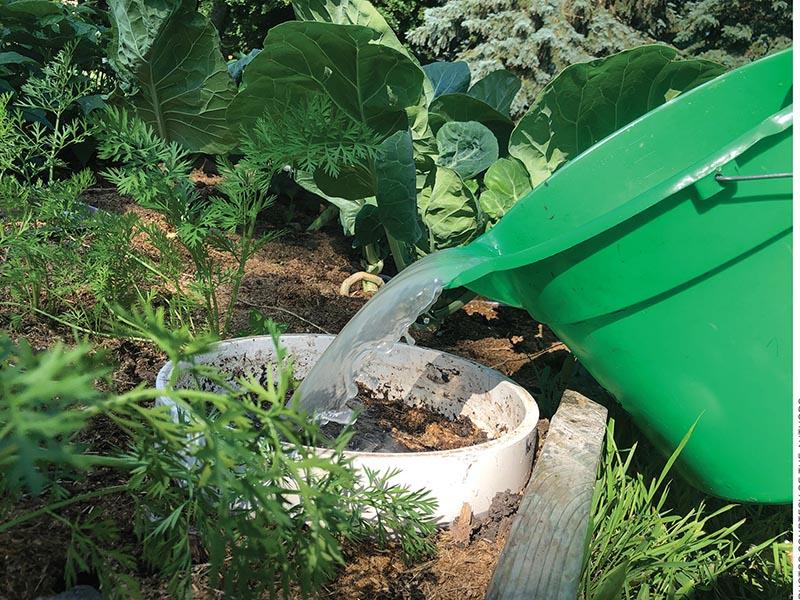
Expert tips

- First, I recommend trying to remove the insects mechanically - they are collected in a container, taken away from the site, unlike flying individuals, soldiers will not be able to return back;
- In the home you should act the same way - do not immediately apply insecticides, you can collect the insects and take them out, but if they are hiding, create intolerable living conditions - use strong-smelling substances.
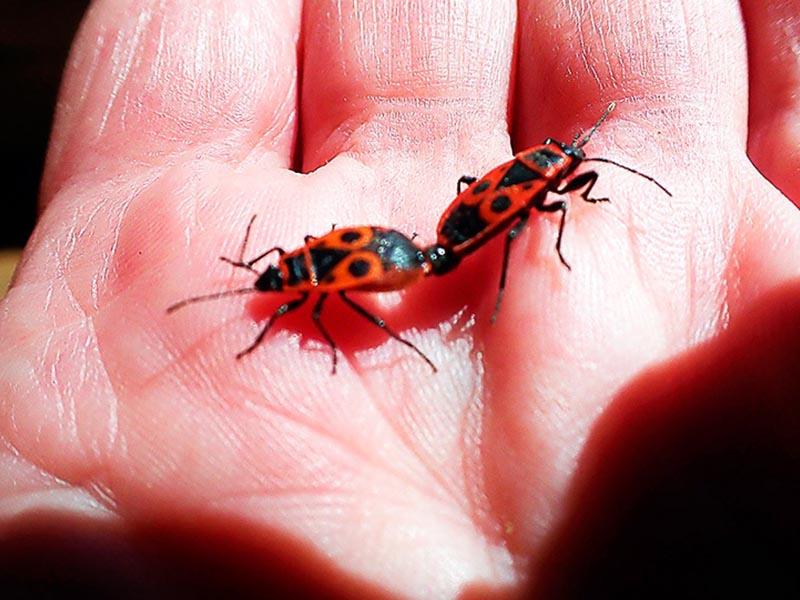
Conclusion
The soldier represents the group of the Red-blooded Clopus. It is distinguished by its appearance - red-black outer covers with an interesting pattern (in the form of circles and triangles). It is not a bug, so it should not be confused with a "firebug". Distinguish pests knowledge of the soldier's appearance will help:
- The bedbug lives literally everywhere in the world, in Russia - all over the territory. It reproduces quickly, for which an unusual method is provided - the ends of the insects' bodies are joined, in this position they travel to their destination.
- The pest does not bite and humans should not be afraid of it. However, when the food source disappears, insects of this species may attack cultivated plants (in the garden or vegetable garden). They are omnivores (polyphagous), so they feed on various plantings and insects as well as invertebrates.
- Soldiers do not live at home. They end up in the apartment by accident.
